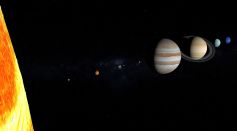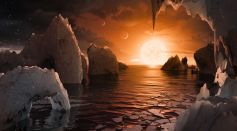Tags: Solar System

How Fast Does Each Planet in the Solar System Spin? Watch These Planetary Animations To Find the Answer
NASA Lucy Spacecraft Glitch: Mission Faces Major Solar Array Issue; Will Engineers Fix This Snag?
Giant Magnetic Tunnel Within Solar System: This Mystery Item 'Covers' Earth, Other Stars in Milky Way Galaxy
Jupiter-Like Planet Survives Death of Its Star; How Did It Happen?
What Was Mars Like in the Past? Scientists Say Red Planet Was More Beautiful Than Earth Before
LOOK: Sharpest Images of 42 Largest Asteroids Released; Features Unique Shapes Like Dog-Bone, Spheres
Engineers Will Be Building a Space Station on an Asteroid as Humankind's Latest Outpost for Interplanetary Exploration
NASA Discovered "Hot Jupiter" Exoplanet, Bigger But Less Massive Than Solar System's Largest Planet
Largest Comet Bigger Than Mars Moons Heading Towards Solar System in 10 Years; Scientists Say There’s No Need To Panic

Mars-Sized Planet Might Be Lurking in Trans-Neptunian Space of the Solar System as Hinted by Computer Simulations
Hubble Space Telescope Detects Winds in Jupiter's Great Red Spot Speeding Up to 400 Miles Per Hour, Does This Makes Sense?
New Planet 9 Theory: Earth-Like Body Drifted and Hid in the Outskirts of Solar System
How Did the Planets of Solar System Align on the Same Plane? Orbit Line-Up Explained 4.5 Billions of Years Ago
Planets, Sun, Moon, Asteroids Orbiting on the Same Plane; Reason for Such, Explored From 4.5 Billion Years Ago
Go Skywatching This Week As the Moon Creeps Up to Saturn, Jupiter When They Take the Spotlight
Bizarre Dog Bone Shaped Asteroid Spied on Best Images Yet Via the Very Large Telescope
Planet 9: Is Its Existence in the Solar System True or Is It Just an Illusion? Here's What Studies Say
Sun After Its Death: Scientists Predict How, When It’s Going to Happen; What Will the Solar System Look Like Then?

Planet Nine Lurking Near Sun’s Orbit? Scientists Spot Planet Around Solar System
Stars Gobble Up Planets; Instability of Solar Systems Could Help Identify Sun-Like Stars Hosting Earth-like Planets
Most Popular

Largest Known Volcanic Aquifer Discovered Beneath Oregon's Cascades

New 'Supergiant' Sea Bug Found in South China Sea, Named After Darth Vader

Mediterranean Sea Was Refilled by a Catastrophic Flood Millions of Years Ago

Mysterious Cosmic Waves That Sound Like Birds Detected in Unexpected Space Region




